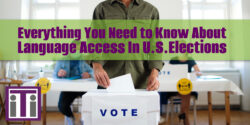Your best interpreting option for someone who is deaf or hard of hearing depends on several factors including the skills of the person with the hearing loss and the situation.

The person who requires interpretation may be skilled in sign language or may rely primarily on written messages. Also note that many people who are hard of hearing can speak even though they can’t hear.
Use A Professional
If the interpretation involves critical information (health, medical or legal issues are examples) be sure to use a professional certified interpreter who has experience interpreting for people who are deaf.
Effective communication is particularly important in a healthcare setting where miscommunication may lead to misdiagnosis or other dangerous and avoidable problems.
In a legal case where the future of the person who is hard of hearing can be gravely affected, communication must be thorough and precise.
Below is a short list of your interpretation options for deaf or hard of hearing individuals.
You’ll find that a professional interpreter may excel in some situations with a person who is deaf but not be qualified or comfortable in other situations.
For example, the interpreter may know sign language but if the hearing challenged person communicates mainly through lip reading and hasn’t learned sign language, then you need to find another interpreter.
Click here for tips for working with ASL interpreters
Sign Language
While sign language is common, not all people who are deaf know sign language. For those who do speak sign language, American Sign Language (ASL) is often the first language that they acquire and use.
ASL is a recognized language with a unique syntax, grammar, and structure. It is not a form of English.
Sign language is a visually interactive language that uses a combination of hand motions, body gestures, and facial expressions.
There are several different types of sign language, including American Sign Language (ASL), British Sign Language, and Signed English.
In the United States, the Department of Education’s Rehabilitation Services Administration funded the establishment of the National Consortium of Interpreter Education Centers (NCIEC).
The NCIEC works to address the need for sign language interpreters through research and education. NCIEC has five regional centers and one national center. All centers work together to increase the supply of qualified interpreters nationally, and improve interpreting education programs (IEPs).
Oral Interpreters
Some people who have difficulty hearing are trained in speech reading (lip reading). But even good lip readers may miss many words. And only 25-30% of spoken English can be lip read.
Oral interpreters are specially trained to articulate speech silently and clearly. Sometimes oral interpreters rephrase words or phrases to give higher visibility on the lips. Oral interpreters also use natural body language and gestures.
When a person is reading lips, a professional interpreter will enunciate clearly, but not yell or over enunciate. Raising the voice or using overly precise enunciation distorts lip movements.
Professional speech reading interpreters never have any object in the mouth (cigarette, pipe, gum, chewing tobacco, or food). They keep their hands or any other objects from covering their mouth. They tend to not have mustaches since that can interfere with a lip reader’s ability to read lips. And professionals sit with a light source (such as a window) in front of them, not behind them.
Video Remote Interpreting (VRI)
With video remote interpreting (VRI), the person with the hearing issue is in a room with video conferencing equipment. This equipment can be a computer with a web camera, a smart phone, or a tablet.
The interpreter appears on screen. This remote interpreter, working in a call center, listens through a headset to what is being said and interprets it. The deaf person watches the interpreter on the screen. Likewise, the interpreter is able to see the deaf person via the camera.
VRI works well for last-minute needs or in emergencies when there’s no time to get a professional interpreter on site quickly. VRI also helps businesses or facilities needing to serve deaf customers.
A key advantage of VRI is that it can be accessed immediately without the user having to pay last-minute fees. Minimum time fees can be lower than for regular interpreting, and there are travel fees.
One disadvantage of VRI is that the benefits of in-person contact are lost. Some people understand interpreters better if the interpreter is with them in person.
An obvious disadvantage of VRI can be dependence on technology — if the equipment is not working, interpreting cannot take place.
Computer Assisted Real-time Translation (CART)
Many people who are deaf or hard of hearing are not trained in either sign language or speech reading.
CART is a service in which an operator (usually a stenographer) types what is said into a computer that displays the typed words on a screen.
In the United States CART can be requested as a reasonable accommodation under the Americans with Disability Act (ADA). CART is used in courtrooms, meetings, conferences, legislative sessions, schools and other settings.
Repeat: Always Use A Professional
No matter how hard of hearing the person is or what type of interpretation service you use, do go with a professional, certified interpreter.
One example of what not to do is to use a person who knows how to sign and can converse casually with people who are deaf. If your interpreter isn’t a certified professional he or she won’t have the training and expertise to accurately interpret or to understand the interpreter role.
Interpreters must understand confidentiality and other issues that can arise in an interpreting situation (like cultural and language differences).
All certified Interpreters adhere to a strict code of ethics that stresses confidentiality, impartiality and integrity.
Click here for more information on the benefits of professional interpreters
Maintain Respect
Finally, be sure you treat the person who is deaf or hard of hearing with the same respect and dignity you would give to anyone else.
If they speak orally and prefer to do so, let them.
Respect their intelligence. Deafness does not affect intelligence. Speaking louder to someone who can’t hear you doesn’t help.
Can you share an experience you’ve had with interpreting for someone with a hearing issue? What did you learn? What went well? What would you change in the future? We would love if you share your thoughts below in the comments!






Comments are closed here.